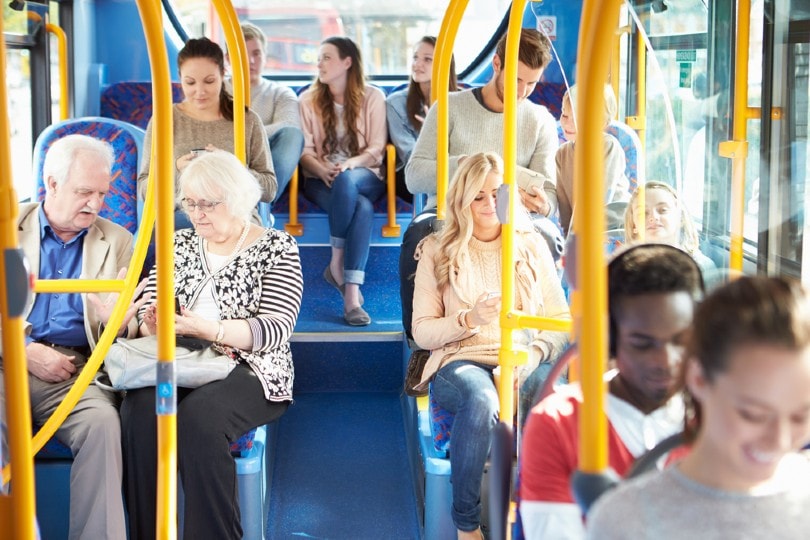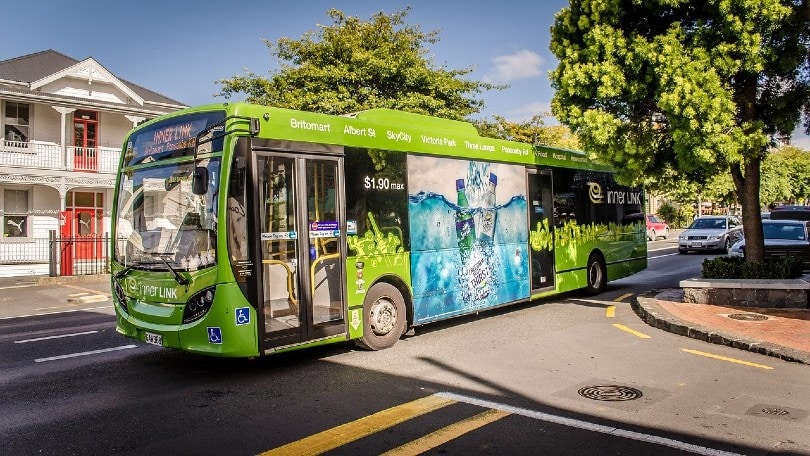Why Don’t Buses Have Seat Belts? History, Reasons, & Safety
-

- Last updated:

Safety has been, and will always be, the top priority for automotive manufacturers and car buyers. The most standard piece of safety equipment that you can expect to find in every car is a seat belt. It is essentially mandatory in the US for people to wear seat belts while in a car, whether as a passenger or a driver. This is on account of how many lives they save in case of catastrophic accidents. Yet, given the restraint requirements in roadworthy vehicles, how come buses don’t have seat belts?
When sitting in a metal container traveling at speeds of at least 80 miles per hour, you probably want some mechanisms in place to protect you in case of a collision. But since buses are typically heavier and larger than most cars on the road, they distribute crash forces differently than passenger cars, light trucks, and vans. They are less likely to sustain damage in case of an accident. Moreover, seats in most buses are equidistant from each other. This creates compartments that absorb the impact of sudden stops or collisions.
The 4 Reasons for Seat Belt Omission in Buses
There is still a rather feverish debate on whether it is necessary to have seat belts installed in bus seats. For the last four decades, the National Transport Safety Board (NTSB) has vigorously advocated for the installation of safety features in buses and trains. The recommendations have unfortunately fallen on deaf ears because they are not enforceable laws despite the potential to save lives.
Below are several reasons why buses lack safety belts.
1. It’s Not a Law Requirement
City coaches and school buses would have seat belts installed if the law required them to. In fact, federal law dictates that only vehicles under 10,000 pounds or 5 tons are required to have seat belts installed. This is why you will notice smaller buses have lap-shoulder seat belts while bigger coach buses roam free without them.
However, some states in the United States have passed laws that make seat belts mandatory in school buses of all sizes. This decree was passed after some horrific accidents that claimed the lives of innocent school-going children. The eight states include Arkansas, California, Florida, Louisiana, Nevada, New Jersey, New York, and Texas.
2. It’s Expensive
Another reason buses lack seat belts is that it is quite expensive to install them. According to studies conducted by the National Highway Authority in conjunction with the University of Alabama, adding seat belts in buses would raise the cost of a bus from $8,000 to a whopping $15,000 without affecting the safety of the passengers. Additionally, it can cost between $1,100–$1,600 per bus to add seat belts at the factory, and even more to retrofit a bus.
NHTSA claimed¹ that the increased costs of buses and the reduced seating spaces and other unintended repercussions of installing safety belts would discourage the use of buses as a regular means of transport, especially for school children. Though rarely said out loud, installing safety belts to reduce the fatality rate of seatbelt-related accidents (approximately 11 passengers per year) doesn’t justify the enormous cost.

3. Physics
Buses typically travel faster than other vehicles on the road. The other vehicles might be the same size, but they tend to weigh less than the standard school, city, or coach buses. Since the body mass is directly proportional to the bus’s momentum, even if the bus collides with another vehicle, it doesn’t sustain as much damage. So, the passengers are less likely to be thrown off their seats, making seat belts unnecessary features in a bus.
4. Easier Evacuation
In case a bus gets into an accident, the lack of safety belts will mean easier evacuation. This is an important consideration, especially when dealing with panicked passengers such as schoolchildren. Enforcing seat belts in school buses would be impractical because the children would struggle to free themselves and escape through the emergency exit without help in the rare event of a crash.
The faster the passengers can get out of the ill-fated bus, the less likely they are to experience serious accident injuries. The lack of safety belts will also make it easier for emergency personnel to access the accident victims.
How Compartmentalization Boosts Safety in Buses
Back in 1987, a study by the National Transport Safety Board (NTSB) looked into several accidents involving buses without safety belts. In their study, NTSB concluded that bus safety belts are not necessary because closely spaced bus seats essentially function as seat belts. This is a bus feature known as compartmentalization. Their chief justification was that the seats essentially prevent passengers from being thrown around in case of a sudden stop or collision.
In 1989, a National Academy of Science study came to a similar conclusion. The seats are put equidistant from one another, separating passengers in small partitions. This concept is similar to that used in storing eggs in egg trays. The eggs are kept protected by storing them in small separate compartments. This is the same design used in buses.
The seat in front of the passenger is usually decently padded and high enough to stop your forward motion in case of a sudden stop or collision. So, the passengers are protected from collision effects by the sturdy, closely spaced seats that absorb energy from the crash. However, this is only a passive safety measure that doesn’t guarantee maximum safety.

Progress Made in Acquiring Safety Belts for Buses
Even though there hasn’t been any official declaration for coach buses to have seat belts, there have been murmurs in federal circles about passing legislation that makes it mandatory to install seat belts and other safety features on highway coaches. This rumbling has intensified with the recent increase in fatal bus crashes.
Unlike the school bus industry, which is still slow to take up the seat belt challenge, the highway coach industry is not waiting for the official legislation to be passed. As of today, about 80% of new coach buses have seat belts installed. However, since highway coaches have a life cycle of up to 20 years, it will be a while before all of them have seat belts.
There has been little progress in adopting the installation of safety belts in city buses compared to highway coaches and school buses. Practically speaking, there is little need for seat belts in city buses. The design of the modern city bus may be less safe than that of school buses. City buses travel at a significantly slower speed, approximately 35 miles per hour. The slow speed limits the chances of high-impact collision.
Moreover, since most city bus trips are short-lived and many trips have standing passengers, the presence of seat belts will make less of a difference.
Safety Measures When Riding a Bus
Even though one doesn’t need to be tethered to a seat when traveling, passengers shouldn’t be moving around the bus. If you have chosen a bus as your means of transport, ensure that you follow these safety measures to have a safe and enjoyable ride.
Seating
While most buses may have large seats, there should never be more than two people per seat. You should also ensure that your arms and legs are tucked safely inside the bench’s edge. Additionally, keep your arms, legs, and head inside the bus at all times.
Baggage and Other Objects
While most bus safety features prevent passengers from being jostled around, so should the luggage. To prevent accidents, make sure that you store your bags under seats or hold them in your lap. Anything stored on the bus’s aisle can go flying forward if the bus stops abruptly. For extra safety, only carry soft-shell backpacks. Any hard or sharp-edged luggage should be stored in the cargo compartment under the bus.

Infants and Car Seats
If you happen to be traveling with an infant in a bus, there are fixtures available for their car seats. It’s not recommended to carry your child in your arms or an unsecured car seat. In case you want to travel for long distances in a coach, make sure to board one equipped with clips.
Conclusion
Clearly, seat belts are important safety measures that save countless lives in case of an accident. They also prevent possible injuries in case of a sudden stop. Despite being mandatory to wear a seat belt in a moving car, it is unnecessary to strap one on while on a bus. There is also no legal requirement to wear a seatbelt on a bus.
Whether a coach, city, or school bus, buses are generally safer than most vehicles. This is because the closely spaced seats function as safety belts, reducing the risk of being thrown out of your seat. Installing seat belts in buses is also quite expensive and considering buses travel at considerably higher speeds and weigh heavier than 5 tons, seat belts are not a mandatory requirement according to federal law.
Fortunately, bus owners, especially coach owners, are realizing the importance of installing seat belts in their vehicles. Schools are still slowly implementing the seat-belt initiative, but not all states have fully adopted it into their legislation. All in all, buses, in general, are designed in a way to ensure the safety of our loved ones. Still, seat belts would boost the safety of passengers while traveling in a bus.
Featured Image Credit: Monkey Business Images, Shutterstock
Contents

